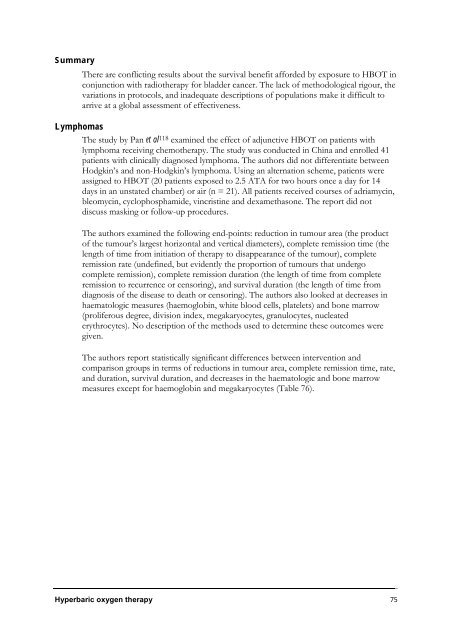Hyperbaric Oxygen Therapy - Hyperbaric Chamber Information ...
Hyperbaric Oxygen Therapy - Hyperbaric Chamber Information ...
Hyperbaric Oxygen Therapy - Hyperbaric Chamber Information ...
Create successful ePaper yourself
Turn your PDF publications into a flip-book with our unique Google optimized e-Paper software.
Summary<br />
There are conflicting results about the survival benefit afforded by exposure to HBOT in<br />
conjunction with radiotherapy for bladder cancer. The lack of methodological rigour, the<br />
variations in protocols, and inadequate descriptions of populations make it difficult to<br />
arrive at a global assessment of effectiveness.<br />
Lymphomas<br />
The study by Pan et al 118 examined the effect of adjunctive HBOT on patients with<br />
lymphoma receiving chemotherapy. The study was conducted in China and enrolled 41<br />
patients with clinically diagnosed lymphoma. The authors did not differentiate between<br />
Hodgkin’s and non-Hodgkin’s lymphoma. Using an alternation scheme, patients were<br />
assigned to HBOT (20 patients exposed to 2.5 ATA for two hours once a day for 14<br />
days in an unstated chamber) or air (n = 21). All patients received courses of adriamycin,<br />
bleomycin, cyclophosphamide, vincristine and dexamethasone. The report did not<br />
discuss masking or follow-up procedures.<br />
The authors examined the following end-points: reduction in tumour area (the product<br />
of the tumour’s largest horizontal and vertical diameters), complete remission time (the<br />
length of time from initiation of therapy to disappearance of the tumour), complete<br />
remission rate (undefined, but evidently the proportion of tumours that undergo<br />
complete remission), complete remission duration (the length of time from complete<br />
remission to recurrence or censoring), and survival duration (the length of time from<br />
diagnosis of the disease to death or censoring). The authors also looked at decreases in<br />
haematologic measures (haemoglobin, white blood cells, platelets) and bone marrow<br />
(proliferous degree, division index, megakaryocytes, granulocytes, nucleated<br />
erythrocytes). No description of the methods used to determine these outcomes were<br />
given.<br />
The authors report statistically significant differences between intervention and<br />
comparison groups in terms of reductions in tumour area, complete remission time, rate,<br />
and duration, survival duration, and decreases in the haematologic and bone marrow<br />
measures except for haemoglobin and megakaryocytes (Table 76).<br />
<strong>Hyperbaric</strong> oxygen therapy 75



